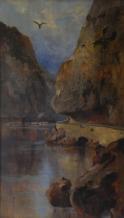Karol Pongrácz presented in his work variations and tendencies of Impressionism and Luminism in open air landscape painting...
Karol Pongrácz presented in his work variations and tendencies of Impressionism and Luminism in open air landscape painting at the end of the 19th and at the beginning of the 20th century.
The birthplace of the author was Sotiná, Záhorie, Slovakia. He spent his childhood and secondary school years in Nitra where his father worked as a royal notary. After leaving the secondary grammar school he studied at the Technical University in Budapest. He gained the visual art education in Munich, Deutenhoffen, Paris and Rome. Later he did a follow-up studies in Budapest at the studio of the Hungarian painter Simon Hollósy. During his studies in Munich he met Ferenc Olgyaym who took him to the southern Hungary region, into Szolnok, where Pongrácz became a co-founder of the Szolnok painter´s society which united the prominent landscape painters working according to the luministic tendencies.
From the very beginning Karol Pongrácz emerged as a skilled landscape painter whose interest was concentrated on the so called intimacy painting and panoramatic views with natural and urban motifs. His artistic opinion developed in the close connection to the open air painting style of luministic type according to the Barbizon school of painting (also mid-19th-century French painting). Pongrácz´s work has also a very important documentary nature, because he preserved the important historical dominants and urban areas not only from Nitra, but also from other Slovak towns. The records form his journeys around Europe also remained there. In 1896 he was awarded a golden medal at the international exhibition of visual art in Budapest for the large scale painting ´Iron Gate on the Danube´ which is a part of the Art Acquisition Fund of Nitra Gallery. We can commemorate his mastership currently with this work which has except of its artistic value the documentary value.
The composition of the work ´Iron Gate on the Danube´ also called ´Iron Gate´ presents the landscape scenery on the river Danube near the towns Orşova and Drobeta – Turnu Severin located in the western Valašsko (Romania). The gorge iron gate is one of the most difficult ships passages passing the rocky Carpathian notch consisting of a chain of mountain ranges that exceed 1,500m. It forms a beautiful sky-line in the narrow valley.
Pongrácz decided to paint exactly this motif. He captured the majesty of the mountain ranges which took his breath. He managed to paint the perspective brilliantly using the luministic features and contrast colourity. The earthy tones of the landscape are enlightened by the goldish colour, the sunny atmosphere of the air in which he included the bird – the symbol of freedom – flying over the river Danube. In the right part of the painting there is situated the historical rock-hewn stony Roman road. Pongrácz´s work reflects the authors aspiration for identifying with the reality by means of the most unstable natural phenomenon – the light. Two years after the painting the picture the landscape scenery changed and remained captured only in the pictures or in the work of some painters who were, like Pongrácz, attracted by this majestic part of the Romania.
The first director of Nitra Gallery, JUDr. Štefan Valent (1908-2007) introduces this artwork as follows: ´The painting has its special value not only regarding the authorship of the artist originally from Nitra, but also because of the fact that the ship Nitra which carried for many years passenger ships and cargos is anchored between the trappy cataracts. The model of the ship is located in the Vienna Technical Museum.´ The works by Karol Pongrácz can be found in the collections of Slovak museums and galleries and they are also represented in various European art institutions.

